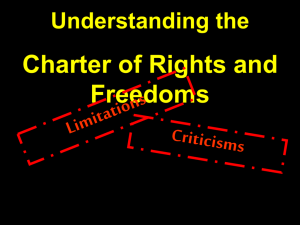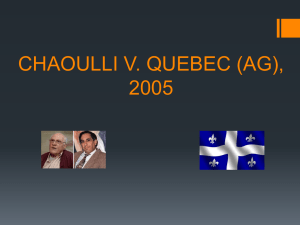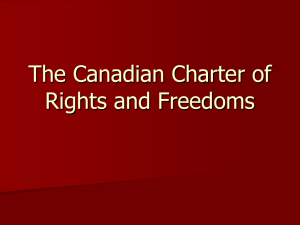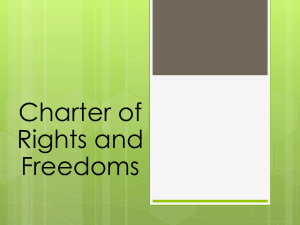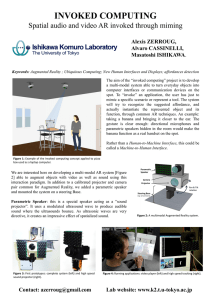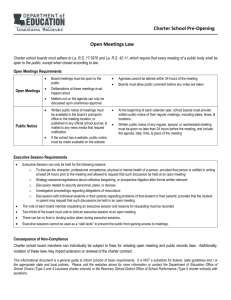About Limitations Limitations: •Section 1
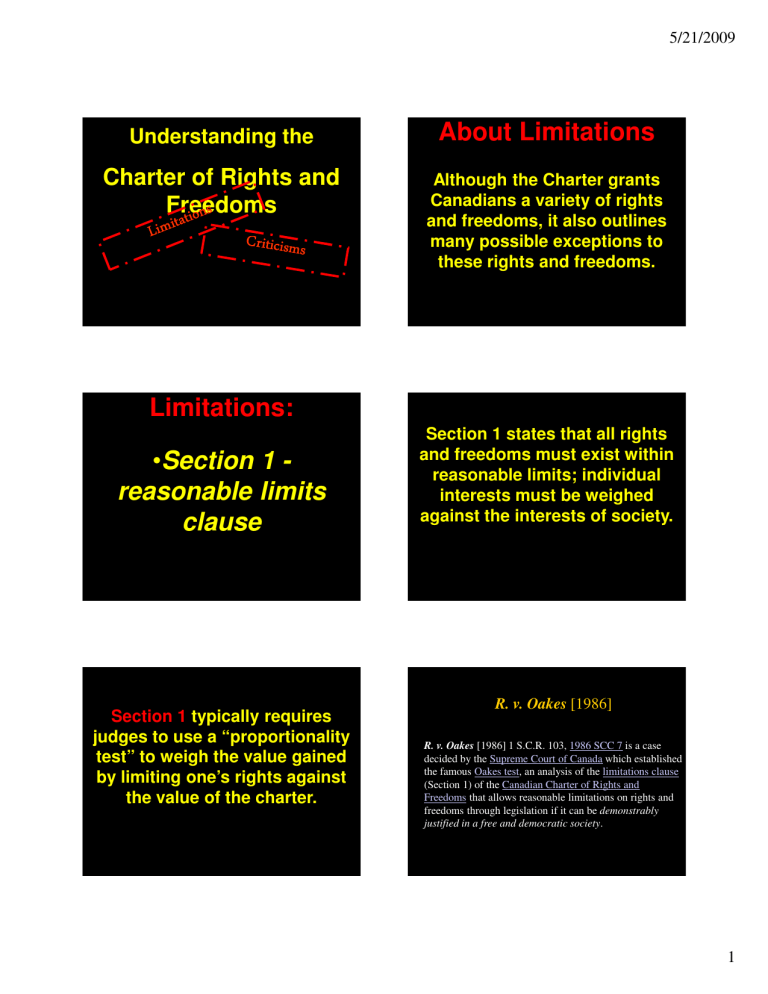
Understanding the
Charter of Rights and
Freedoms
About Limitations
Although the Charter grants
Canadians a variety of rights and freedoms, it also outlines many possible exceptions to these rights and freedoms.
5/21/2009
Limitations:
•
Section 1 reasonable limits clause
Section 1 states that all rights and freedoms must exist within reasonable limits; individual interests must be weighed against the interests of society.
Section 1 typically requires judges to use a “proportionality test” to weigh the value gained by limiting one’s rights against the value of the charter.
R. v. Oakes [1986]
R. v. Oakes [1986] 1 S.C.R. 103, 1986 SCC 7 is a case decided by the Supreme Court of Canada which established the famous Oakes test , an analysis of the limitations clause
(Section 1) of the Canadian Charter of Rights and
Freedoms that allows reasonable limitations on rights and freedoms through legislation if it can be demonstrably justified in a free and democratic society .
1
5/21/2009
Background:
An individual named David Edwin Oakes was caught with vials of hash oil as well as $619.45. Accordingly, he was charged with intended trafficking , under s.4(2) of the Narcotic Control Act (NCA), despite Oakes' protests that the vials were not meant for trafficking and that the money he had was from a workers' compensation cheque.
Section 8 of the Narcotic Control Act provided for a shift in onus onto the accused to prove that he was not in possession for the purpose of trafficking. Oakes made a constitutional challenge, claiming that the
“reverse onus” created by the presumption of possession for purposes of trafficking violated the presumption of innocence guarantee under s.11(d) of the Charter.
The sole issue before the Court was whether s.8 of the NCA was constitutional.
Decision:
The Court was unanimous in holding that the shift in onus violated both Oakes's section 11(d) rights and indirectly his section 7 rights .
Moreover, there was no rational connection between basic possession and the presumption of trafficking, and therefore the shift in onus could not be justified in a free and democratic society.
The Court described the exceptional criteria under which rights could be justifiably limited under section 1. The Court identified two main functions of section 1.
• First, "it guarantees the rights which follow it", and
• Secondly, it "states the criteria against which justifications for limitations on those rights must be measured".
The key values of the Charter come from the phrase "free and democratic society" and should be used as the "ultimate standard" for interpretation of section 1. These include values such as:
“respect for the inherent dignity of the human person, commitment to social justice and equality, accommodation of a wide variety of beliefs, respect for cultural and group identity, and faith in social and political institutions which enhance the participation of individuals and groups in society.”
Charter rights are not absolute and it is necessary to limit them in order to achieve
"collective goals of fundamental importance".
The Court presents a two-step test to justify a limitation:
First , it must be "an objective related to concerns which are pressing and substantial in a free and democratic society", and second it must be shown "that the means chosen are reasonable and demonstrably justified".
The second part , described as a "proportionality test," requires the invoking party to show:
I, the measures adopted must be carefully designed to achieve the objective in question. (They must not be arbitrary, unfair or based on irrational considerations. In short, they must be rationally connected to the objective.)
II, the means … should impair "as little as possible" the right or freedom in question.
III, there must be a proportionality between the effects of the measures which are responsible for limiting the Charter right or freedom, and the objective which has been identified as of "sufficient importance".
In applying this test to the facts the Court found that section 8 does not pass the rational connection test as the “… possession of a small or negligible quantity of narcotics does not support the inference of trafficking ... it would be irrational to infer that a person had an intent to traffic on the basis of his or her possession of a very small quantity of narcotics ." Therefore, section 8 of the Narcotics Control Act is in violation of the Charter and is of no force or effect.
Analyses:
This was the first case to consider the application of section 1 of the
Charter and was used as a test case to set the foundation for the Courts to analyze the Charter. The test developed in this case has since gone through significant evolution due to subsequent case law, however, the test has remained fundamentally the same.
•
Section 15, subsection (2) affirmative action clause
2
Section 15(2) , states that equality under the law does not preclude any law designed to compensate disadvantaged groups.
•
Section 33 notwithstanding clause
5/21/2009
Section 33 permits any legislature to declare a law to pass despite many rights/freedoms set out in sections 2 and 7-15.
Section 33 has only been used by
Quebec, Saskatchewan and
Alberta.
Federal Parliament has never invoked the notwithstanding clause.
examples…
Quebec, 1988: The Liberal government invoked it to protect Bill 178, its French-language sign legislation.
Saskatchewan 1984: The Tory government invoked it while legislating provincial employees back to work
Alberta, 1998: The Alberta government invoked it to restrict compensation it must pay to hundreds of victims of enforced sterilization between 1928 and 1972.
More Examples
- Quebec, 1982-1988: The Parti Quebecois government invoked a blanket use of the notwithstanding clause, applying it to all acts passed between 1982 and 1985.
- Saskatchewan 1984: The Tory government invoked it while legislating provincial employees back to work.
- Quebec, 1986: The Liberal government invoked it in legislation amending the pension plans of teachers and other public-sector workers.
- Quebec, 1986: The Liberal government invoked it in legislation dealing with "agricultural operations."
- Quebec, 1986: The Liberal government invoked it in education legislation.
- Quebec, 1988: The Liberal government invoked it to protect Bill 178, its French-language sign legislation.
- Alberta, 1998: The Alberta government invoked it to restrict compensation it must pay to hundreds of victims of enforced sterilization between 1928 and 1972.
3
5/21/2009
NOTE: If Section 33 is to be invoked it must be stated within the legislation. This gives opportunity for the opposition to raise concerns.
NOTE i): A heavy political price
(in terms of public opinion) is invariably paid when Section 33 is invoked.
NOTE ii): Declaration under
Section 33 expires (is of no force) after five years. It must then be redeclared.
Criticism 1
•
transfers ultimate legal authority from the elected legislature to the judiciary
Criticism 2
•
rights are now static
(beyond the realm of legislative reform)
Criticism 3
•
inspires more frivolous litigation
Criticism 4
•
inspires a focus on individual rights as opposed to collective rights
4
